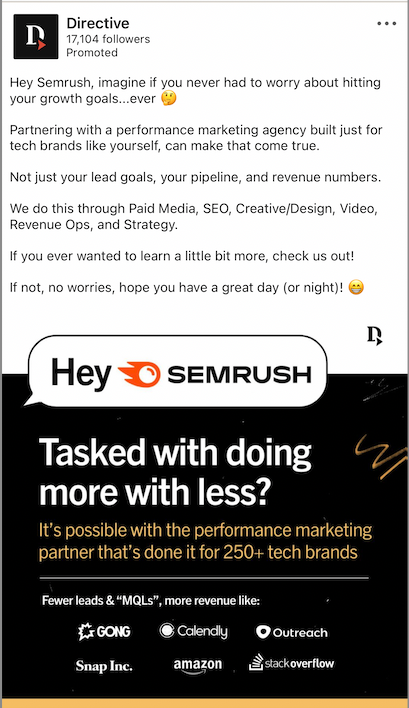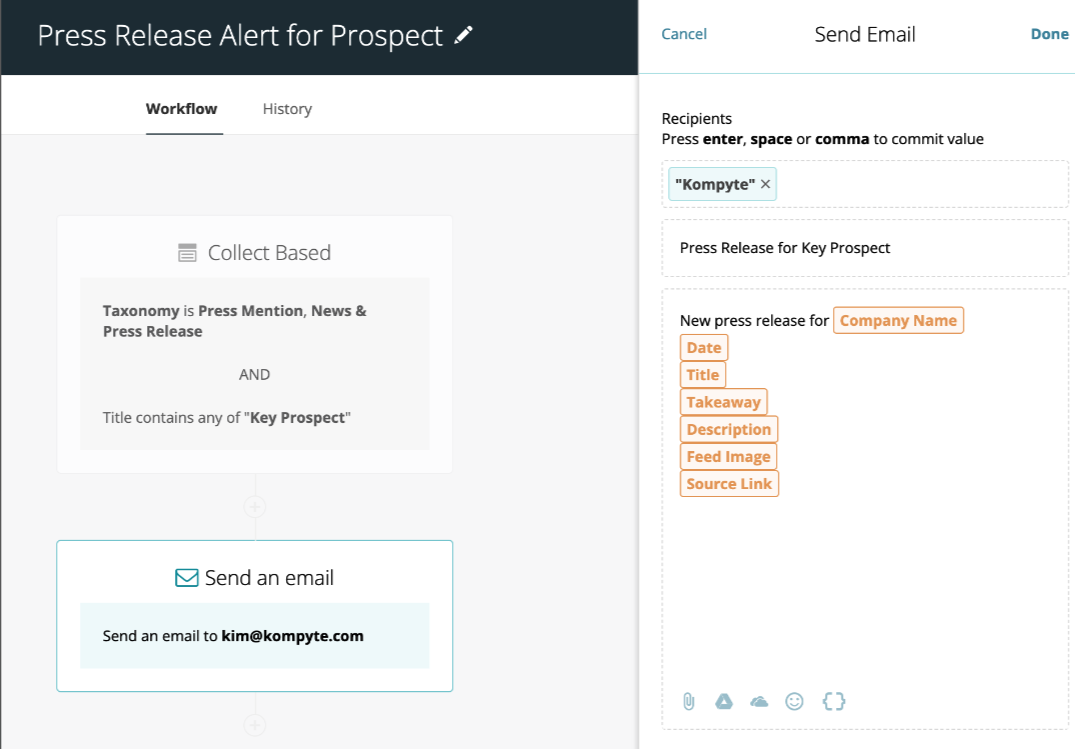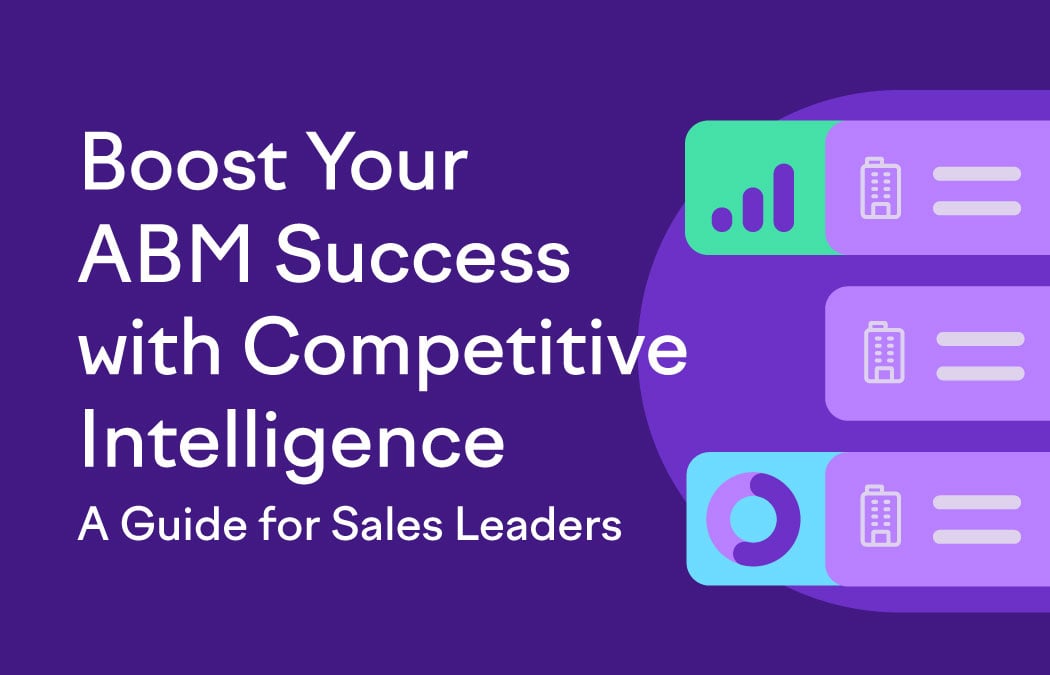Competitive intelligence can propel your account-based marketing (ABM) strategy from focused to unstoppable — optimizing performance and driving higher ROI.
Account-based marketing (ABM) is a targeted approach to sales and marketing that focuses on only the highest-value accounts. ABM is especially useful when those high-dollar contracts come with a long sales cycle.
ABM can help you attract, retain, and even upsell customers, as well as to shorten the sales cycle. Rather than a typical one-to-many marketing approach, ABM employs a one-to-one method, which can be highly effective. In fact, 76% of B2B marketers who used ABM in 2020 reported an increased ROI compared to other forms of marketing.
The clear, shared focus ABM brings to both the sales and marketing teams results in higher-quality leads and an increase in cooperation across functions.
Here's a perfect example. Directive targeted Semrush employees with a message that feels very relevant and personal.

ABM provides marketers with a strategic framework to nurture the highest potential accounts and funnel high-quality leads to their sales teams. - Tony Smith, Seismic
Competitive Intelligence and ABM — What's the Connection?
To tailor each (often costly) interaction for maximum relevance, you'll need an in-depth understanding of customer needs and preferences. And remember, you're not the only one targeting these high-value customers. So, it's critical that you stay ahead of the competition and become the more attractive option. You'll do this largely by leveraging competitive intelligence.
Competitive intelligence gives you the insight needed to differentiate your solutions and gain an advantage. You'll use it to:
- Learn more about your target customers
- Evaluate your current position in the market
- Identify gaps in your strategy
- Counter competitor activities
- Become irresistible to your dream customers
First, an unconventional use for competitive intelligence:
Use "Competitive Intelligence" to Understand Your Target Customer
In this step, you aren't analyzing your competitors' behavior at all. Rather, you're learning everything possible about the customers you want to attract. But you'll be using many of the same techniques and tools that you'll use when you analyze your competitors.
Here are some of the things you should learn:
- Company Basics: This includes information about the company size, location(s), industry, and revenue. You should also understand the company's history, mission, and values. (Kompyte can help with this!)
- Key Decision-Makers: Identify key decision-makers and influencers from sources such as the company "About Us" page, LinkedIn, business directories, press releases, and event speaker lists. Go beyond names and job titles to understand their roles, responsibilities, and their position within the company hierarchy.
- Business Goals and Challenges: Learn what the company's business objectives are and what obstacles they face in achieving them. Then you'll know how your product or service can help them reach their goals or overcome their challenges. Look at a competitor's website, annual reports, and customer reviews to see where they may be struggling.
- Current Solutions: Find out which solutions they're currently using that are similar to your product or service. This knowledge can give you an idea of why they might want to switch to your offering. You may be able to figure out what they're using by finding case studies that feature the competitor as a customer.
However, you may have more success by looking at job postings. If the company requires expertise in product X, you know they're using it!
- Company Culture: Company culture can influence decision-making, so try to understand their corporate environment, core values, and organizational attitudes. One of the best ways to do this is to follow influential and non-influential employees on social media — particularly on LinkedIn. You can also learn a lot from employee reviews on Glassdoor and similar sites.
- Buyer Personas: Within the target company, there are likely multiple buyer personas. Understanding these can help you further tailor your messaging and marketing efforts. For example, users of your product might be sales representatives in their late twenties who's just trying to reach quota this quarter. But the decision maker may be a CRO in her forties responsible for revenue generation and retention across the company.
- Past Interactions: Review any past interactions between your company and the target account, learning as much as you can from them. Meaningful engagements could include previous purchases, service history, co-marketing, in-person networking, etc.
- Recent News or Events: Keep an eye on recent news or major events involving the company. Look for product launches, changes in executive leadership, financial performance, mergers, and acquisitions, etc.
- Competitive Landscape: Understand who their competitors are and how they position themselves in the market. Look for comparison blog posts such as "(Company name) Alternatives."
Once you have all of this information, make sure it is available to every sales and marketing professional on your team. We recommend formatting these as Battlecards. You'll also want to update this information regularly. The best way to do this is by using competitive intelligence automation. Learn more.
If you don't have marketing and sales aligned and using the same set of data, then you're not really doing ABM. — Liam Doyle, SVP of Product Management, Salesforce (source)
Understand Your Competitor's Strategy
Insight into competitors' marketing strategies is key to differentiating your own marketing and winning those customers. You may also discover some areas you've overlooked, or find a weakness or two you can exploit by doubling down on where they're slacking. Here are some ways to find out which marketing strategies your competitors use today:
- Website and Blog Analysis: Look at your competitors' websites, blogs, and any downloadable resources. Take note of the topics, tone of voice, and themes. Watch for updates to pricing and product pages in particular.
- Social Media: Follow your competitors on various social media platforms. Notice what they post, how often, and how they interact with followers. Pay attention to which platform they use most heavily.
- Email Newsletters: Subscribe to your competitors' email. Pay attention to the content they share, the frequency of their emails, and their calls to action.
- Customer Reviews: Scan review sites to find out what customers like/dislike, and any changes in their responses over time. You can ask an AI program such as Bard to summarize recent reviews to reveal common likes and dislikes.
- SEO Tools: Use SEO tools like Semrush to analyze your competitors' keyword strategy, backlink profile, and more. Get a sense of topics they're prioritizing and how they're driving organic traffic.
- PPC Ad Analysis: Tools like Semrush and Kompyte can help you analyze your competitors' PPC (pay-per-click) ad strategy. You can discover which keywords they're bidding on, see their ads, and even see which ads are performing well. Pay special attention to any ads that mention the names of any companies they are targeting.
- Webinars, Podcasts, and Conferences: Attend industry webinars, listen to podcasts, and go to conferences where your competitors are speaking.
- Public Relations: Watch press releases and news for valuable insights into new products, services, partnerships, or marketing initiatives.
- Job Postings: Marketing job descriptions often provide detailed insight into planned areas of focus.
- Market Research Firms: Finally, professional market research firms can provide reports on various industry players. While these services can be expensive, they may offer the most comprehensive and detailed analysis of your competitors' strategies.
Competitor strategy analysis is a worthwhile endeavor, to be sure, but to keep on top of constant changes, you need competitive intelligence automation.
Use Competitive Insights to Become Irresistibly Relevant
Competitive insights help sales teams develop and refine their strategies, identify customer needs and wants, evaluate competitor strengths and weaknesses, target customers who may be dissatisfied with the competition, and track competitor activity to position yourself as the smartest, best choice.
Here are some key ways to use competitive insights to increase your relevance in the eyes of your target customer:
Learn More About (and then cater to) Customer Preferences: Analyze customer feedback and study social media conversations about competing products or services. This feedback helps sales teams learn exactly what your shared audience cares about. Use these insights to tailor and position offerings more accurately while also creating a communication strategy that resonates with prospects.
Target Disgruntled Customers: Focus on individuals who aren't pleased with the product or service your competitors provide. Watch social media and review sites, or online forums for complaints and conversations. Social listening tools and competitive intelligence solutions like Kompyte, can alert you to mentions of your competitors across the web.
When you implement these two simple steps, your ABM program will be off to a flying start with the help of competitive intelligence.
Real-world Examples of Account-based Intelligence
Organizations using account-based intelligence can gain an important strategic advantage in their marketing campaigns by adding competitive intelligence. Here's how some Kompyte customers do it.
Tracking Key Customers
Once you've signed a new customer, keeping the high-touch relationship alive is key to retention and upselling services.
Company news provides a great icebreaker for a friendly "congratulations" email, while a notice of layoffs might mean this isn't a good time to convince them to upgrade their service.
You can also get specific about what kind of news you want to see.
One of our customers, for example, highly values sustainability, so they watch to see if their customers are mentioned in connection with that topic, allowing them to reach out on a topic they have in common. Maintaining that connection can make a world of difference when it comes to retaining customers.
Tracking Prospective Customers
One Kompyte customer segments prospective customers by industry, tracking nearly 200 of them at a time. Watching press releases and key insights for one segment at a time allows them to spot trends that can help them to sell.
For example, are several prospects in the healthcare industry making large acquisitions? This might be a good time to reach out to this segment.

Here, we've set up a process in Kompyte so that, whenever there is a new press release for one of our prospects, Kim receives an email notification.
Tracking Key Partners
Is there a company you'd like to partner with but you just haven't found a good "in" yet? Watch for company news that calls for a "congratulations" email or LinkedIn message. Or, keep an eye on upcoming events they'll be attending and arrange to meet them there.
Researching Potential Acquisition Targets
Automated Battlecards create the perfect template for quick research on potential acquisition targets. Pulling in company size, revenue, funding information, and other key indicators, can help you prioritize your targets.
All of these use cases call for tracking a combination of key insights, press releases, news, events, hiring, and website changes. Updates are typically accessed in Battlecards or in an email digest - whatever fits your preferred workflow. All of which, by the way, is very easy to do with Kompyte!
Next Steps: Bringing Competitive Intelligence into your ABM Program
Competitive intelligence, when added to your account-based marketing program, will help you:
- Better understand your target customers
- Evaluate your own position in the market
- Identify your own strategy gaps -- and those of your competitors'
- Counter competitor activities
- Make your offering irresistibly appealing
When you need to overshadow your competition with a more focused, differentiated, and successful ABM strategy, competitive intelligence is your secret weapon.
Keeping all this crucial information up-to-date and accessible to your sales and marketing teams is a must. It's at this point that a competitive intelligence automation tool comes in handy, providing real-time updates and well-organized insights.
So, why not take your ABM strategy to the next level? Get a demo of our competitive intelligence automation tool today, and see how it can transform your approach to account-based marketing.



